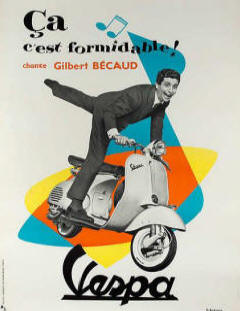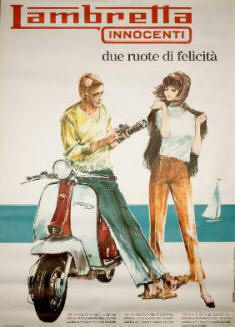|
Only in Italy could an ugly U.S. military
motorcycle be the catalyst that led to the creation of a style icon. With
over 16 million scooters sold, the Vespa has become synonymous with style,
freedom and all things Italian. The name alone conjures up images of
beautiful people in beautiful places, an image that was further propagated
by Fellini, who had the sultry Anita Ekberg ride one in his cinematic
masterpiece La Dolce Vita.
The Vespa was inspired by the small olive-coloured
Cushman Airborne motorcycles that were dropped by parachute during WWII into
the Italian industrial heartlands of Milan and Turin to be used by troops in
the fight against the Germans.
Two wars are highly important features on the
Vespa timeline. Built by Piaggio, the factory founded in Genoa in 1884 by
Rinaldo Piaggio to fit out luxury ships saw the First World War facilitate a
change in product and the company who was now manufacturing rail carriages
and coaches went into the production of aircraft, including seaplanes.
In 1917, Piaggio built a new plant in Pisa and,
four years later, took over another in Pontedera to build high-tech P-180
engines for bombers. During the Second World War, Piaggio’s aeronautical
plants became strategic military targets and suffered many attacks, until
August 31, 1943 when they were razed to the ground.
With Allied help, the factories were rebuilt and,
remembering the small motorcycle made for parachutists, Enrico Piaggio
assigned Corradino D’Ascanio the task of designing a motorcycle suitable for
getting around the bomb-damaged Italian cities.
The aeronautical designer, however, was not keen
on motorcycles, thinking them too cumbersome, difficult to repair and dirty.
Using his expertise he overcame these problems to create a scooter that
would not only win the hearts of so many but was a marvel of design and
practicality. The gear lever was moved onto the handlebar for easier access;
to eliminate the tyre changing problems motorcycles had, he used a
supporting arm, similar to those in aircraft rather than a fork, and, using
his aeronautical knowledge, made the body to absorb stress in the same way
as an aircraft would. The seat position was designed to give both safety and
comfort while the workings were hidden behind panels to keep the rider’s
clothes in pristine condition and the step-through frame meant it was an
ideal machine for skirt-wearing women to ride.
It is said that in 1946 when D’Ascanio showed the
prototype, it was Enrico Piaggio, who, because of its narrow waist and
buzzing sound, named it la
Vespa, meaning the wasp.
The Debut
On April 23, 1946 Piaggio applied for a patent
with the Central Patents Office at the Ministry of Industry and Commerce in
Florence, describing the Vespa as “a motorcycle with a rational complex of
organs and elements with body combined with the mudguards and bonnet
covering all the mechanical parts”.
The first glimpse of the Vespa the public saw was
on the cover of the popular Italian magazine La
Moto on April 15, 1946 and, following this, it was launched at the 1946
Milan design fair, a year ahead of its competitors, Lambretta. The reaction
to the machine led to many copy-cat designs coming from overseas; Japan
produced the Fuji rabbit, Germany produced several rival scooters with even
Great Britain producing what it saw as a competitor, however in truth no
rival company managed to match the beauty and charm of the little Italian
scooter.
Piaggio propelled by the positive reactions to the
scooter went into production with the Vespa 98, which sold well with the
first years’ output being 2,484. This led to the larger 125 cc model being
launched in 1947. In its second year, the production had gone up to 10,353
and further increasing by 9,500 by the end of 1948. The sales of the Vespa
have continued to grow and, in June 1956, the millionth scooter rolled off
the production line; 1960, a mere four years later, the number would rise to
two million, paving the way for the scooter to go down in history as a
unique phenomenon in the worlds’ motorised travel history.
Lights, Camera,
Action!
With its popularity and innovative design, it
didn’t take long before the sexy little scooter started to appear in stylish
magazines being photographed alongside models wearing the couture of the
day.
Soon just the name, Vespa, was linked with high
fashion and images of handsome men zipping along narrow Italian streets or
beautiful girls with their hair billowing behind them as they rode along
coastal roads, creating a link with style that remains today.
Hollywood has always had a
love affair with the Vespa: in the 1953 film Roman
Holiday, it could be argued that the scooter
should have also received star billing after Gregory Peck and Audrey
Hepburn, as it’s the images of them riding it through Rome that have helped
the film endure. |




|
|
Even today, it seems, if a movie is set in Italy,
it must have a Vespa featured: recent films have included The
Talented Mr Ripley and American
Graffiti; glamorous celebrities
who’ve been photographed alongside a Vespa include Joan Collins, Ursula
Andress and Raquel Welch, Henry Fonda, Antonio Banderas, Jude Law, and Gwen
Stefani can be see riding one in her 2007 pop video Now
That You Got It.
With the exception of Roman
Holiday, probably one of the most famous movies to feature the Vespa
is Quadrophenia, the rock opera
written by The Who and set in the 1965 world of British Mod culture.
Outside of Italy, the second largest market for
the Vespa was Britain. Style was important to the Mods in their sharp suits
and fish-tailed parkas, and they adopted the Italian scooter as part of
their look and went on to customise it with extra lights and mirrors added
to its tiny frame. During the 1960’s bank holidays, Britain’s seaside
resorts were swamped by Vespa riding mods, some looking for trouble due to
the unwritten vendetta with the Rocker culture, but most to preen and show
off on their scooters.
The Vespa continues to sell worldwide and the
little wasp-waisted scooter has been elevated from a simple machine to a
concept that is recognised internationally. The image is now big business
with the company selling millions in merchandising, everything from
sunglasses to shirts and wall clocks to calendars. The Vespa remains one of
the fashion industry’s enduring members of royalty, and it has no intention
of giving up its crown just yet.
 |
|
VISIT OUR SHOP |
HOW TO ORDER? |
ASK US ANYTHING |
|
Shop all our vintage scooters and accessories. Go crazy! |
Learn ins and outs of our shop and how we can serve you. It's easy! |
To
have your questions answered or to place an order. Get in touch! |
|
|







